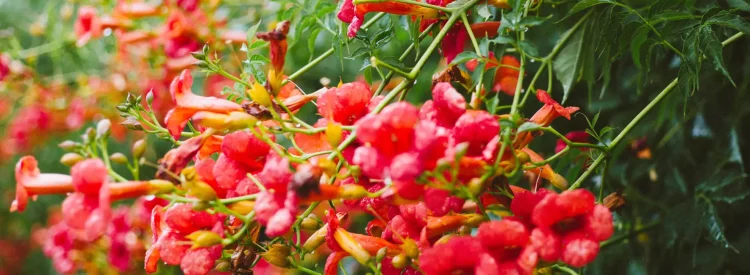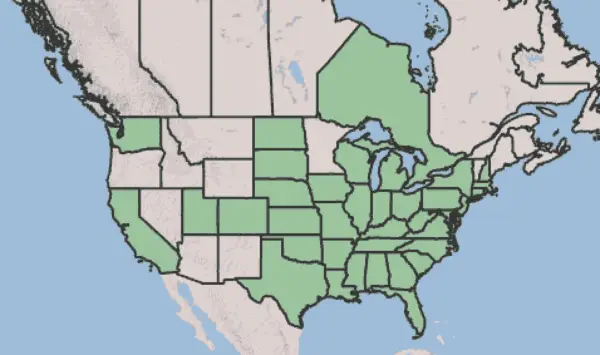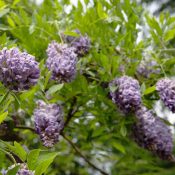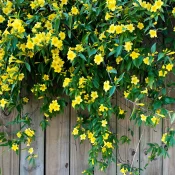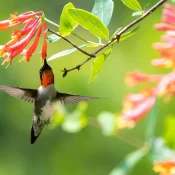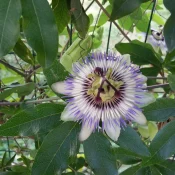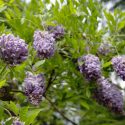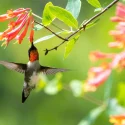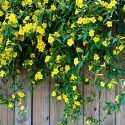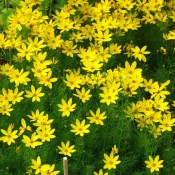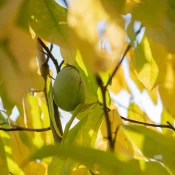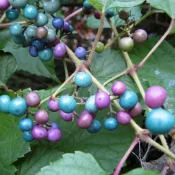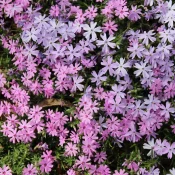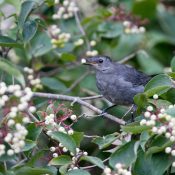This native vine is as easy-going as it gets. Trumpet vine thrives in full sun to part sun, soil that is moist or dry, and even in clay. The main complaint you’ll hear is that it grows too fast! Pruning keeps it in check. Scroll on for planting tips.
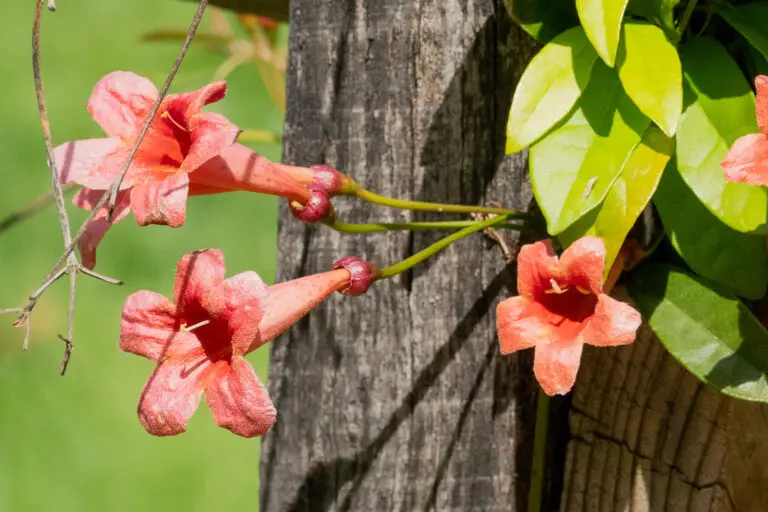
Trumpet vine (Campsis radicans) is a native vine that brings instant drama to any yard. With bright, trumpet-shaped blooms that quickly cover fences and trellises, it’s one of the easiest ways to add color and attract hummingbirds. In this article, we’ll cover what makes trumpet vine such an easy-going favorite, how to grow it successfully, and a few tips for keeping it in check.
Let’s start with a basic question…
Is trumpet vine a good choice for my yard?
- Yes, if you want a dramatic, fast-growing native vine that brings hummingbirds.
- Yes, if you have a fence, trellis, pergola, or sturdy structure that needs covering.
- Yes, if you like low-maintenance plants that will come back year after year, even if neglected.
- Yes, if you’re comfortable with pruning; this plant gets big when it’s not kept in check. (No fancy tools required: all you’ll need is a $6 pair of clippers.)
New to native?
Before lawns and landscaping, native plants were here. They’ve fed birds, bees, and butterflies for thousands of years—and they’ll do the same in your yard. The best part? They’re easier to grow than you think.
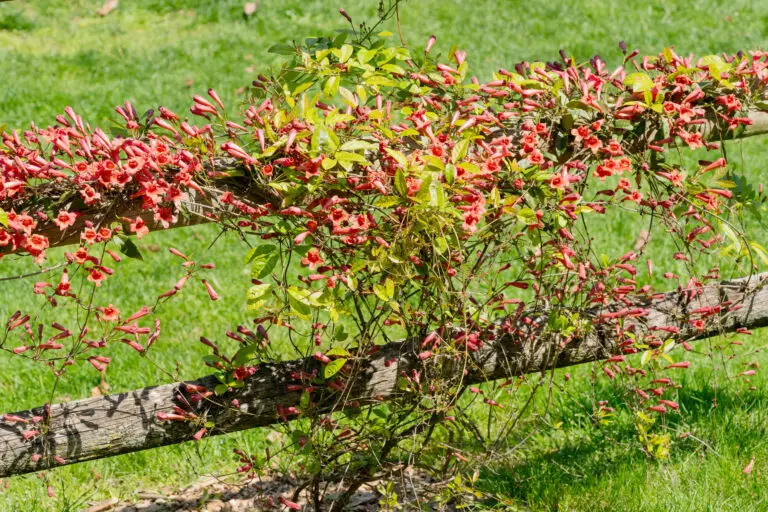
How to grow trumpet vine
There are a few things to note as you consider planting trumpet vine in your yard:
- Give it support. Trumpet vine is a true climber. It needs a strong trellis, fence, pergola, or arbor to sprawl across. Avoid planting it directly against your house, since its aerial roots can cling tightly to walls.
- Expect it to spread. This vine grows fast and can spread by suckers and underground runners. Plant it where it has room to roam—or be ready to prune and pull unwanted shoots each year.
- Full sun = more flowers. It can tolerate some shade, but trumpet vine flowers best in bright sun.
- Prune for control. Blooms form on new wood, so cut it back hard in late winter or early spring to encourage fresh growth and keep it manageable.
Once established, trumpet vine is drought-tolerant and will thrive with little care. But keep in mind: you’ll need to be handy with pruning to keep it in check.
Where is trumpet vine native?
Trumpet vine has a HUGE native range that includes 70% of North America.
Is trumpet vine invasive?
Many gardeners warn against planting trumpet vine because “it’s invasive.” But here’s the truth:
Invasive = non-native + harmful.
Trumpet Vine is native, so it’s not invasive.
The better word is aggressive. Trumpet vine spreads quickly and grows big—sometimes up to 30 feet in a single season once established. And a single plant can produce more than 1,000 seeds. Left on its own, it can easily take over.
You can keep trumpet vine in check by pruning
Here’s how to prune and keep them in check:
- Fall prune to stop seed spread. Trim vines after flowering so they don’t go to seed.
- Spring prune for maximum blooms. Trumpet vine flowers on new growth, so cutting it back hard means more flowers.
As Katie Schmidt of the Dyck Arboretum in Kansas puts it:
“To keep this thing [Trumpet Vine] in control means relentless pruning.”
Or, as the New York Botanical Garden says:
“It can be a lovely plant, as long as it always knows you’re the boss.”
If that’s not for you, can we recommend some other native vines?
What are some other native vines?
You’ve got quite a few options! Here are some others to consider:
Where can I find trumpet vine?
We are not going to lie and say that finding native trumpet vine is going to be as simple as driving to your closest plant nursery. It might take a little extra energy to find this native gem, but it is worth it! Here are some recommendations for sourcing this native plant:
Where can I find seeds and plants?
Finding native plants can be challenging (we partly blame Marie Antoinette.) To make it easier, we’ve assembled four sourcing ideas.
300+ native nurseries make finding one a breeze
Explore 100+ native-friendly eCommerce sites
Every state and province has a native plant society; find yours
Online Communities
Local Facebook groups are a great plant source
What are good pairings for trumpet vine?
Pairings depend on the spot where it’s planted. For full-sun gardens, we recommend fall-blooming favorites like native asters and springtime favorites like golden alexander.
And that wraps up our beginner’s guide to trumpet vine. Yes, it’s a vigorous grower, but that’s not always a bad thing. Give it strong support and some space, and you’ll be rewarded with spectacular trumpet-shaped blooms that call in hummingbirds all summer long. Since it’s a perennial, you plant once and enjoy the show for years to come. Curious about more wildlife-friendly climbers? Check out our Beginner’s Guide to Coral Honeysuckle or our Beginner’s Guide to Passionflower Vine. Or plant a hummer paradise and read our What Are the Best Plants for Hummingbirds? Happy planting!
Sources
- U.S. Forest Service, Usda.gov. “Invasive Plants,” 2025.
- Chachalis D, Reddy KN. Factors affecting Campsis radicans seed germination and seedling emergence. Weed Science. 2000;48(2):212-216. doi:10.1614/0043-1745(2000)048[0212:FACRSG]2.0.CO;2
- Schmidt, Katie. “Plant Apologies: Campsis Radicans – Dyck Arboretum.” Dyck Arboretum, April 5, 2023.
- Tilly, Nikki. Gardening Know How. “Trumpet Vine Care – How to Grow Trumpet Vines in the Garden,” May 14, 2021.
- New York Botanical Garden, Nybg.org. “Are Trumpet Vines Invasive in the Middle Hudson Valley? – NYBG Mertz Library Reference,” May 12, 2025.
What if your feed was actually good for your mental health?
Give your algorithm a breath of fresh air and follow us.
